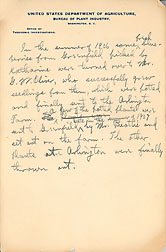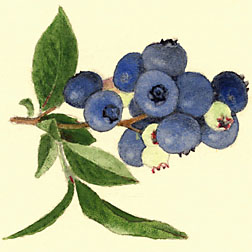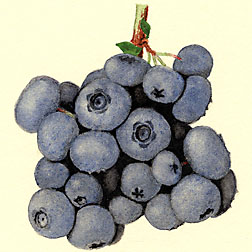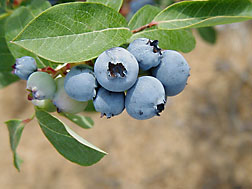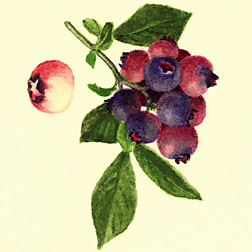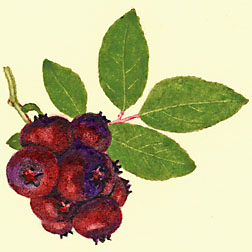Blueberry Growing Comes to the National Agricultural Library
|
|
The path to domestication for most of our crops is lost in the mists of agriculture’s 10,000-year history. Blueberries are the exception.
Until 1911, blueberries were picked from the wild, or bushes were dug from the wild that might or might not survive when planted elsewhere. But true domestication—reproduction at the will of a grower and breeding to improve desirable traits—was beyond reach. This makes blueberries among the most recently domesticated crops and one of the few that originated in North America, although they are now grown all over the world.
It was U.S. Department of Agriculture botanist Frederick Coville who set the stage for commercial production by solving the first great mystery of why blueberries could not be cultivated well when he showed, in 1910, that the plants must be grown in moist, very acidic soil. Soon after, he made the first successful crosses designed to improve important traits, such as berry size and flavor. The blueberry was tamed.
Now Coville’s handwritten research notes have been added to the Rare and Special Collections at the National Agricultural Library (NAL), in Beltsville, Maryland. The material includes complete descriptions of blueberry plant parentage and field note data as well as daily, penciled entries of his work. There are also more than 1,000 black-and-white photographs of blueberries and more than 100 glass-plate negatives and positives from USDA blueberry research.
The records provide a fascinating look at the USDA research effort that took blueberries from a crop picked from the wild and sold for 14 cents a quart in 1912 to a commercially grown crop worth more than $530 million today.
Coville’s notes provide insight into how monumental a task it was to begin transforming blueberries into a domesticated crop. In his June 1, 1907, entry, he quotes a statement that the renowned botanist Liberty Hyde Bailey “once got a bushel of blueberries…and failed to make a single seed grow.”
Paging through his observations clearly shows the evolution of his how-to-grow blueberry studies. His records begin with comparing plant growth in alkaline, neutral, and acid soil. By 1908, Coville had pretty much dropped alkaline soil from testing. In growing studies done at Arlington Farm (now the south parking lot of the Pentagon), Coville wrote, “Peat was procured yesterday from underneath some Kalmia (mountain laurel) bushes on the Virginia side of the Potomac opposite Plummer’s Island.” He had remarkable success with this very-low-pH soil. While most plants prefer soil at the neutral pH 7, blueberries only thrive at pH 4.5 to 4.8. It was a novel concept at the time and one that Coville, in his later years, said he considered his greatest discovery.
In 1910, Coville published Experiments in Blueberry Culture (USDA Bulletin 193), with his directions for growing blueberries. He expanded these directions in a number of revisions over the years.
|
|
Then Coville went on to solve the second mystery of why blueberries could not be bred as easily as most other plants when he discovered that blueberries are not self-fertile and that they require cross-pollination. He also recognized that each parent must have an equal number of chromosomes, something not necessarily the norm in a genus as variable as Vaccinium.
Coville was also the first to determine how to propagate blueberries, allowing production of thousands of identical plants once a good hybrid was bred. This was critical to the large-scale production of consistent, uniform blueberry fruit. Prior to his research, it was believed that blueberries couldn’t be propagated.
In 1911 came his landmark first successful crosses between two wild blueberries—one highbush and one lowbush—that had been selected for their superior qualities from a pasture in Greenfield, New Hampshire. These were named Brooks and Russell. The crosses he made in 1911 and 1913 resulted in 3,000 hybrids. Another cross of Brooks with a wild blueberry named Sooy in 1912 resulted in another 3,000 seedlings.
“From these, over 1,000 seedlings were actually transplanted [to the field] and as many more might easily have been utilized,” was the assessment Coville recorded.
These crosses led to the release of the first hybrid, aptly named Pioneer (Brooks x Sooy), in 1920, followed by the release of Cabot and Katherine.
Much of Coville’s original wild breeding stock came from his partnership with Elizabeth White of Whitesbog, New Jersey. She acquired high-quality bushes by recruiting native blueberry pickers to locate and tag desirable large-fruited bushes for use as parental stock, and then she personally went out and brought them back to Whitesbog and made them available to Coville.
|
|
Coville’s crosses continued to be released for many years after his death in 1937 and included Bluecrop, Blueray, and Earliblue, varieties still popular today with gardeners and commercial growers. By 1942, of the 18 blueberry varieties offered by eastern growers, 14 were the result of Coville’s selection or breeding. His varieties remain part of the pedigree of most varieties grown today.
The USDA research program Coville founded in New Jersey continues today, carrying out critical research to protect and expand the U.S. blueberry crop. Consumer demand continues to increase at a rapid pace, especially since the recognition of blueberry’s health benefits.
The NAL’s Rare and Special Collections hopes to raise funding to scan the Coville records along with other blueberry material it has recently received so that the records can be available via the Internet. Some of the additional material includes blueberry virus data from 1943 and 1944, USDA pomologist George Darrow’s notes and photographs on rest-period requirements for blueberries, and nursery catalogs from 1943 to 1970 with sources listed for a number of cultivars.
“Coville’s research notes give historians and scientists an opportunity to follow both the thinking and progress of one of the foremost breeders in the world as he developed the first blueberry cultivars,” says Robert Griesbach, a plant geneticist who is currently deputy assistant administrator for ARS’s Office of Technology Transfer. “These notes are quite detailed, and besides the observations on genetic advances, they provide insights into the original breeding approaches taken for disease control, production, and the development of the new industry.”—By J. Kim Kaplan, Agricultural Research Service Information Staff.
For more information on this blueberry research collection, contact Sara B. Lee, USDA-ARS National Agricultural Library, Rare and Special Collections, 10301 Baltimore Ave., Beltsville, MD 20705; (301) 504-5876.
"Blueberry Growing Comes to the National Agricultural Library" was published in the May/June 2011 issue of Agricultural Research magazine.







